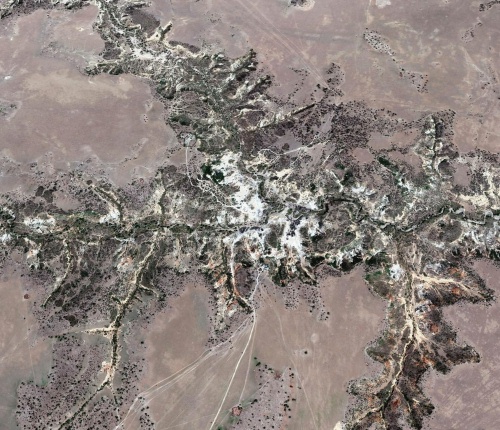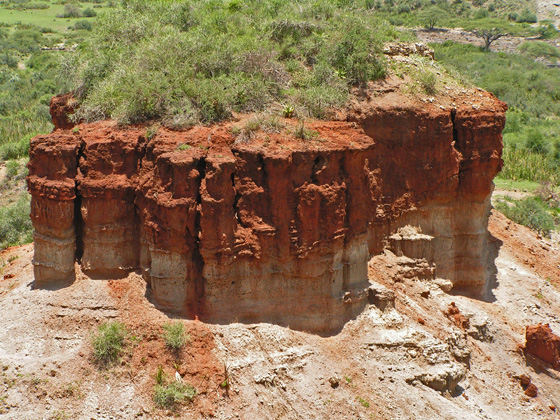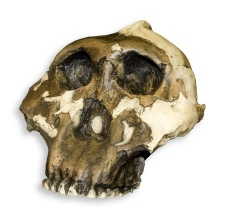Olduvai Gorge is a steep-sided ravine in the Great Rift Valley, which stretches along eastern Africa. The site is very significant because of the human bones found here that have helped us understand the evolution of human history.
The Great Rift Valley

The Gorge
The gorge is a very steep sided ravine roughly 30 miles long and 295 ft. deep.
Olduvai Gorge

Exposed deposits show rich fossils, many hominid remains and items including some of the oldest stone tool technologies, called Olduwan. The time span of the objects recovered date from 2,100,000 to 15,000 years ago.
The primary Olduvai Beds are in a lake basin about 16 miles in diameter. The rocks under the basin date to 5.3 million years ago. There have been seven major Beds distinguished they are ranked from oldest to youngest (Bed I, Bed II, Bed III, Bed IV, the Masek Beds, the Ndutu Beds, and Baisiusiu Beds).
Bed I dates to 2,100,000 years old and is 197 feet thick. It is mainly formed of lava flows, volcanic-ash deposits and other sediments. The upper part of the bed contains varied fauna and evidence of the Olduwan industry. Skeletal remains of hominids are assigned to the Homo Habilis an Australopithecus Boisei families. Campsites and what is believed to be a butchery site have also been excavated from this bed.
The Hominid living sites in Bed I are found mainly where streams from the volcanic highlands carried fresh water to Olduvai lake. The conditions for the preservation of the sites is mainly due to the ash falls from the nearby volcanoes and the inconsistency of the lake's depth. The debris found at the sites are various Olduwan tools, bone and teeth from animals, mainly from fair sized antelopes. Also a loosely built circle of lava blocks was found, suggesting that crude shelters were formed here as well.
The living sites in Beds II-IV are normally found in what would have been river and stream channels. Therefore, many of the sites were displaced by water action.
Bed II is 66-98 feet thick and is 1,150,000 to 1,700,000 years old. It has two main divisions of rock layer, upper and lower, that were separated by an erosional break. The lower part of Bed II is similar to Bed I. The upper part was formed after fault shifts had reduced the ancient lakes size. It is in this part of Bed II that the development of the Acheulian industry starts to show. Here also are the remains of Homo Habilis, Homo Erectus and Australopithecus Boisei.
The gorge was modified by fault shifting and erosion. It is after these geographical changes that Beds III and IV were created. These two Beds range from 1,150,00 to 600,000 years ago. These two Beds are separable only in the eastern part of the gorge and are combined elsewhere into a single unit. They have a maximum thickness of about 98 feet and consists mainly of sediment from streams that fed Olduvai Lake.
During a period of major faulting and volcanism roughly 400,000 to 600,000 years ago, the Masek Beds accumulated. They are up to 82 ft. thick and again contain mostly stream sediments with some aeolian (wind-worked) tuff. It is assumed the climate at this time was probably much like today based on the deposits found there. There is only one major archaeological site found in these beds and it is of the Acheulian tool industry.
The Ndutu Beds were formed by faulting, erosion and the filling of the gorge around 32,000 years ago. It consists mainly of aeolian tuff. In this Bed two sites have been found which date to the Middle Stone Age.
The last of the archaeological Beds is the Naisiusiu. It lays in the bottom of the Gorge at what is now the present depth. It only has a depth of 33 ft and also consists of aeolian tuff. It contains one site that has microlithic tools and one complete Homo Sapien skeleton, both of which date to 17,000 years ago.
Note that the text above is referenced from the New World Encyclopedia at http://www.newworldencyclopedia.org/entry/Olduvai_Gorge
Skull found at Olduvai

Assignment
1. Take a picture next to the layers of earth anywhere along the gorge.
2. Measure the approximate height of the sediment layers in the photograph and in your log suggest a range of time span that is being shown in the picture.
3. Send me an e-mail suggesting how the walls of the valley were formed.